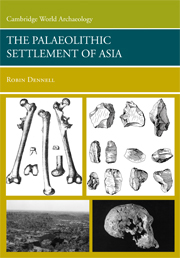Book contents
- Frontmatter
- Contents
- List of Tables, Figures, and Boxes
- Preface
- 1 Asia and Its Place in Palaeoanthropology
- 2 The African Background to the Colonisation of Asia
- 3 The Climatic and Environmental Background to Hominin Settlement in Asia before 1 MA
- 4 The Earliest Inhabitants of Southwest Asia
- 5 The Earliest Inhabitants of South and Southeast Asia and China
- 6 “Out of Africa 1” Reconsidered and the Earliest Colonisation of Asia
- 7 The Climatic and Environmental Background to Hominin Settlement in Asia between ca. 1 Ma and the Last Interglacial
- 8 The Middle Pleistocene Archaeological Record for Southwest and Central Asia
- 9 The Middle Pleistocene Archaeological Record of the Indian Subcontinent
- 10 The Middle Pleistocene Archaeological Record of China and Southeast Asia
- 11 Human Evolution in Asia during the Middle Pleistocene
- 12 Concluding Remarks
- Appendix 1 The Sizes of Countries and Regions in Asia, with Comparative Examples
- Appendix 2 Geographical Coordinates of Principal Early Palaeolithic Sites in Asia
- Appendix 3 Geographical Coordinates of Geological Sections and Cores
- Appendix 4 English Names of Various Mammals Recorded in Asia
- Bibliography
- Index
5 - The Earliest Inhabitants of South and Southeast Asia and China
Published online by Cambridge University Press: 05 June 2012
- Frontmatter
- Contents
- List of Tables, Figures, and Boxes
- Preface
- 1 Asia and Its Place in Palaeoanthropology
- 2 The African Background to the Colonisation of Asia
- 3 The Climatic and Environmental Background to Hominin Settlement in Asia before 1 MA
- 4 The Earliest Inhabitants of Southwest Asia
- 5 The Earliest Inhabitants of South and Southeast Asia and China
- 6 “Out of Africa 1” Reconsidered and the Earliest Colonisation of Asia
- 7 The Climatic and Environmental Background to Hominin Settlement in Asia between ca. 1 Ma and the Last Interglacial
- 8 The Middle Pleistocene Archaeological Record for Southwest and Central Asia
- 9 The Middle Pleistocene Archaeological Record of the Indian Subcontinent
- 10 The Middle Pleistocene Archaeological Record of China and Southeast Asia
- 11 Human Evolution in Asia during the Middle Pleistocene
- 12 Concluding Remarks
- Appendix 1 The Sizes of Countries and Regions in Asia, with Comparative Examples
- Appendix 2 Geographical Coordinates of Principal Early Palaeolithic Sites in Asia
- Appendix 3 Geographical Coordinates of Geological Sections and Cores
- Appendix 4 English Names of Various Mammals Recorded in Asia
- Bibliography
- Index
Summary
INTRODUCTION
Evidence for hominins before 1 Ma across the vast expanses of the Indian subcontinent, Central Asia, mainland and island Southeast Asia, and China is at present very thin on the ground. The most important fossil hominin evidence comes from Java, Indonesia, and the main archaeological evidence is from the Nihewan Basin, North China. There is also a small amount of controversial evidence from Pakistan and South China. After a long period of chronological uncertainty, the earliest generally accepted evidence for hominins in East Asia in both Java and North China now dates to ca. 1.6 Ma. As seen below, opinion remains divided over claims for older evidence from Pakistan and South China. The evidence from South Asia, Java, and China will be considered in turn.
SOUTH ASIA (INDIA, PAKISTAN, NEPAL, AND BANGLADESH)
The environment of northern India and Pakistan differed in two important respects from that of Southwest Asia. The first is that South Asia lies within the area of the summer monsoon, and consequently, most rain falls in summer instead of in winter and spring. Over much of northern India and Pakistan, the average annual total is ca. 500–1000 mm, of which two-thirds falls between July and September. In the eastern Himalayas and Northeast India, totals can be much higher, and at least 3 m of rain may fall in the monsoon (see Chapters 1 and 3).
- Type
- Chapter
- Information
- The Palaeolithic Settlement of Asia , pp. 128 - 185Publisher: Cambridge University PressPrint publication year: 2008



